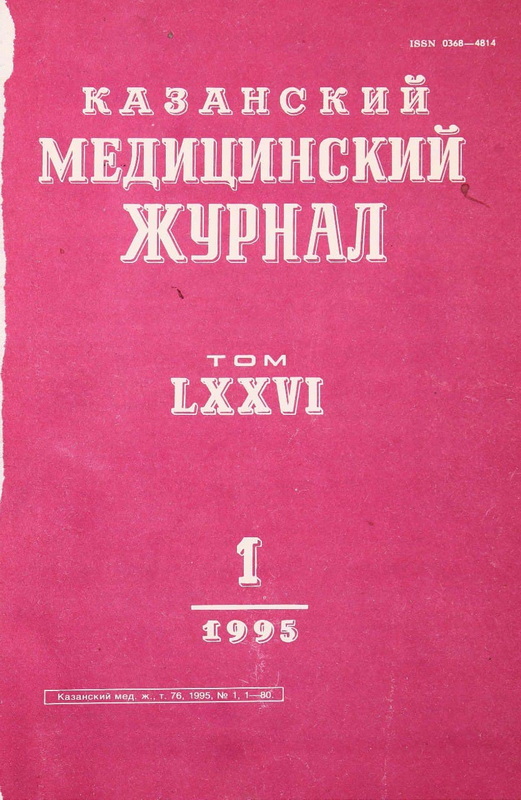Современные методы консервативного лечения больных отосклерозом
- Авторы: Галочкин В.И.1
-
Учреждения:
- Филиал Московского университета города Ульяновск
- Выпуск: Том 76, № 1 (1995)
- Страницы: 59-61
- Тип: Статьи
- URL: https://bakhtiniada.ru/kazanmedj/article/view/82732
- DOI: https://doi.org/10.17816/kazmj82732
- ID: 82732
Цитировать
Полный текст
Аннотация
Тугоухость в результате отосклеротического процесса в лабиринтной капсуле диагностируется у 0,1 — 1% всего населения, являясь таким образом важной медицинской и социальной проблемой. К настоящему времени разработано множество методов хирургической коррекции отосклеротической тугоухости и патогенетического медикаментозного воздействия на отосклеротический очаг в лабиринтной капсуле [10]. Из разнообразных слухоулучшающих вмешательств наибольшее распространение получили стапедэктомия и стапедопластика. Реже используются такие способы операций, как монокруральная транспозиция, стапедиолиз, интерпозиционная техника и др. Благодаря существующему многообразию методов отохирург имеет возможность выбирать рациональное для больного хирургическое вмешательство с учетом индивидуальных вариантов строения среднего уха и визуальной оценки особенностей развития отосклеротического процесса. К настоящему времени техника слухоулучшающей хирургии приближается, можно считать, к идеальному уровню и обеспечивает максимальную функциональную эффективность и социальную реабилитацию больных в 80 — 95% случаев [10 12].
Ключевые слова
Полный текст
Открыть статью на сайте журналаОб авторах
В. И. Галочкин
Филиал Московского университета города Ульяновск
Автор, ответственный за переписку.
Email: info@eco-vector.com
Кафедра последипломной подготовки врачей, зав.— проф.
Россия, УльяновскСписок литературы
- Белкина Н. П., Краева Н. И., Лях Г. С., Микушкин М. К. Реабилитация больных с заболеваниями уха, горла, носа и речи.— Сб. трудов.— 1980.— Том ХХІІІ-А.— С. 46 — 55.
- Галочкин, В. И. Современные методы диагностики и лечения заболеваний уха.— Сб. тр. ЛОР-каф. КГМИ.— Казань, 1985.— С. 24 — 30.
- Галочкин В. И.//Вести, оториноларингол.— 1987.— № 1.— С. 15—18.
- Галочкин В. И. Консервативная терапия отосклероза с целью предупреждения прот грессирования тугоухости: Автореф. дисс. ...докт. мед. наук.— Казань, 1988.
- Гукович В. А., Авраменко Л. В. Тезисы IV съезда отоларингологов РСФСР.— Горький, 1978.
- Гукович В. А., Мартынюк Л. А., Авраменко Л. В.//Журн. уши., нос. и горл. бол.— 1978,—№ 2.—С. 70 — 72.
- Гукович В. А., Федотов А. Ф.//Вестн. оториноларингол.— 1973.— № 1.— С. 65 — 69.
- Никитина В. Ф. Патология уха и реабилитация больных с тугоухостью.— М., 1987.
- Пальчун В. Т., Белякова Л. В., Асламазова В. И. и др.//Вести, оториноларингол.— 1988,—№ 1,—С. 23 — 27.
- Преображенский Н. А., Патякина О. К. Стапедэктомия и стапедопластика при отосклерозе.— М., 1973.
- Решетников Н. Н., Попова Т. //.//Вести, оториноларингол.— 1992.— № 3.— С. 14—16.
- Сватко Л. Г. Отосклероз.— Казань, 1974.
- Сватко Л. Г., Галочкин В. И., Петушков Е. В. Материалы XI конференции отоларингологов ТАССР.— Казань, 1975.
- Arnold W., Friedmann I.//5. Laryngol. Otol.— 1988.— Vol. 102.—P. 865—871.
- Balle V., Linthicum F.//Ann. Otol.— 1984.—Vol. 93.—P. 105—111.
- Bretlau P., Hansen H., Causse J. et al.// Ann. Otol. Rhinol. Laryng.— 1985.— Vol. 94.— P. 103—104.
- Causse J., Causse /.//Ann. Oto-Laryng.— 1980.—Vol. 97.—P. 325—351.
- Causse J., Causse J., Bel J. et al.//Ach oiorhînoîaryngol. Belg-1986—Vol. 40.—P. 482—486.
- Cole J.//Laryngoscope.— 1982.— Vol 92.— P. 863—872.
- Harris J., Ryan A.//Amer. J. Otolaryngol.— 1984.— Vol. 5 — P. 418—425.
- McKenna M., Mills B.//Otolaryng. Head Neck Surg.— 1983.—Vol. 62.—387—390.
- Shrader M., Weber Poppendieck /.// Ann. Otol.— 1990.—Vol. 99,—P. 349—359.
- Shambaugh G., Scott А.ЦА.тс\\. Otolaryng.— 1964.— Vol. 80.— P. 263—270.
- Yoo T., Shea J., Floyd R.//Amer. J. Otolaryngol.— 1987.—Vol. 8.— P. 317—324.
Дополнительные файлы





